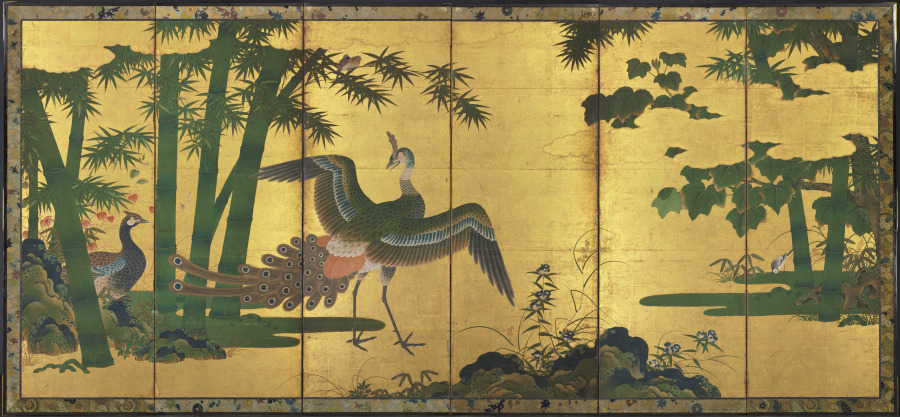| schema:description | "wall_description: The immense heraldic birds on display in these byøbu reflect the Momoyama era's spirit of newly gained self-confidence and an affinity for grand expressive statements in painting, architecture, the textile and ceramic arts, as well as garden design. While that period preceded the arrival of prosperity, it clearly marked an extra---ordinary moment in Japanese cultural history, one frequently compared with the twelfth century of the Heian period. Through the extensive use of gold-foil backgrounds rather than the somber palette of carefully orchestrated ink tones evident in Muromachi byøbu, patrons colla-borated with artists as well as craftsmen in fostering a decidedly new look in much of Japanese painting. Here for instance there is no imaginary vista suggesting China's vast waterways and mountain ranges. The setting is composed instead of highly stylized lozenges of mineral green paint, suggesting the earth from which clumps of grass, flowering plants, and towering bamboo and paulownia trees emerge. Clusters of lumpy, blue-green rocks dotted with lichen provide stabilizing three-dimensional foils for these islands of vegetation as well as the all-encompassing flat, golden surface. The glorious artificiality of the setting precisely serves the artist's effort to compose a credible yet other-worldly vista for depicting the legendary phoenix gazing across the landscape at the pair of peacocks. Rather than an emblem of immortality, as it is in Western lore, in Japan the phoenix evolved out of its origins in Chinese mythology to become, by the sixteenth century, an auspicious symbol of political authority. Together with clusters of the distinctively shaped paulownia leaves, this long-tailed, mythical bird graced lacquerware as well as mural paintings, proclaiming an air of graceful com-mand. A characteristic infusion of temporality has been included also, through a seasonal flowering schema extending from spring to early summer (right) to fall and the advent of winter (left). Although traditionally attributed to the Tosa school master Tosa Mitsuyoshi (1539-1613), these byøbu possess neither seals nor signatures to confirm that authorship. Known for his jewel-like, modest-sized album paintings of courtly narratives such as The Tale of Genji, it is likely both studio training and contemporary fashions in patronage conspired to produce a good number of such byøbu. This example from the Momoyama era represents one such effort from a masterful Tosa painter, too little seen in Western collections....(more)" |
| schema:description | "tombstone: Peacocks and Bamboo, late 1500s. Attributed to Tosa Mitsuyoshi (Japanese, 1539-1613). One of a pair of six-panel screens; ink, color, and gold on gilded paper; image: 160.5 x 362 cm (63 3/16 x 142 1/2 in.). The Cleveland Museum of Art, Leonard C. Hanna, Jr. Fund 1986.2.2...(more)" |

